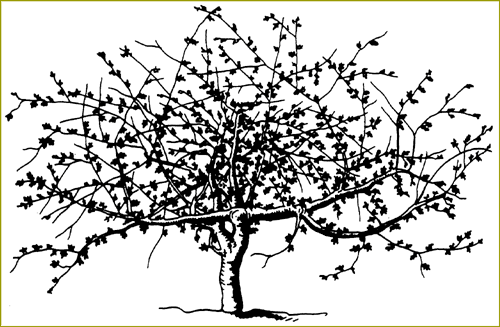

Balm of Gilead (Commiphora opobalsamum)
Folk Names: Balessan, Balsam Tree, Balsumodendron, Baume de la Gileadensis (or Gileadensis), Bechan, Dossemo, Mecca Balsam (Balsamum Meccae), Protium Gileadense
Description: Balm of Gilead grows in countries on both sides of the Red Sea, but it is quite rare and difficult to cultivate. The tree stands from ten to twelve feet high, with wand-like, spreading branches. The bark is a rich brown. The few, small leaves are trifoliate, and the tiny flowers are unisexual and reddish. The fruit is reddish-gray, the size of a small pea, with an agreeable and aromatic taste. Seeds are solitary, yellow, and grooved down one side.
In the heat of summer, the tree’s resinous sap spontaneously exudes from the trunk. The expression of the resin may be facilitated by incisions in the trunk. The more humid the air, the more resin may be collected. The oil is extracted from the resin via secret methods, but the yields only 1/10 the amount of juice. An inferior oil is obtained by boiling the leaves and wood with water.
Effects: gentle
Planet: Venus Zodiac: Taurus
Element: water
Associated Deities:
Traditions:
The name balm, baulm, or bawm is contracted from the word balsam, a word possibly derived from the Hebrew bot smin, meaning “chief of oils,” or basam “balm,” or besem “sweet smell.” instructed David to begin attack on Philistines
Balm of Gilead was taken from Arabia to Judea by the Queen of Sheba as a present for Solomon. There is was cultivated for its juice, particularly at Mt Gilead where it acquired its name.
Magic:
According to tradition, the (P candicans) buds may be carried to mend a broken heart or attract a new love. They may also be steeped in red wine for love potion.
Though the buds (P candicans) may be used in incense for spirit summoning, they are also carried for protection from the evil eye, curses, and hexes.
Balm of Gilead may be used in all healing spells, and the oil can be used to dress candles in healing rituals. The buds (P candicans) may be added to the bath to purify, and will also beautify skin.
Known Combinations:
Populus candicans is also called Balm of Gilead, as is P Nigra and P balsamifera. See Aspen for a description.
Medical Indications: Parts Used: oil
The odorous liquid balm is a thick, turbid grayish-white substance. It quickly becomes solid upon exposure to the air. Though it has been used to treat urinary tracts, it is said to possess no medicinal properties not found in other balms.
Nutrition:
The fruit is edible.
Mercantile Uses:
This tree is so valued by the Turks that its importation is prohibited.